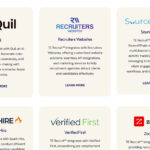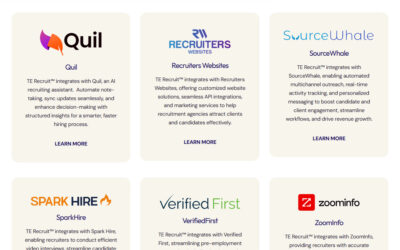In the competitive world of agency recruiting and search consulting, generating leads is just the beginning. The real challenge lies in converting these prospects into valued connections that can lead to fruitful and long-term professional relationships. This process requires a nuanced approach, blending the art of human connection with the science of strategic engagement. This article will delve into the strategies and best practices that can help recruiters and search consultants transform leads into meaningful relationships.
Understanding the Lead Lifecycle
Before diving into specific tactics, it’s crucial to understand the lifecycle of a lead in the recruitment industry. This lifecycle generally includes the following stages:
- Identification: Recognizing potential candidates or clients who might benefit from your services.
- Engagement: Initiating contact and starting a conversation.
- Nurturing: Building rapport and providing value to keep the prospect interested.
- Conversion: Turning the prospect into a client or candidate who actively engages with your services.
- Relationship Building: Maintaining and enhancing the relationship over time to ensure mutual benefit and long-term engagement.
Each stage requires a tailored approach to move the lead smoothly through the pipeline, culminating in a robust and enduring professional relationship.
Identification: The Foundation of a Strong Relationship
The first step in converting leads into valued connections is identifying the right prospects. This requires a deep understanding of the industry, the specific needs of potential clients and candidates, and the ability to spot opportunities where your services can add value.
Leveraging Technology
In the modern recruitment landscape, technology plays a critical role in identifying potential leads. Advanced tools such as AI-powered recruitment software, social media analytics, and CRM systems can provide valuable insights and streamline the process of recognizing promising prospects.
- AI-Powered Recruitment Software: These tools can analyze large volumes of data to identify patterns and predict behaviors. For instance, AI can help determine which candidates are most likely to switch jobs based on their career trajectories and current market trends. This allows recruiters to proactively reach out to individuals who may not be actively seeking new opportunities but are open to offers.
- Social Media Analytics: Social media platforms are goldmines of information. Analyzing engagement metrics, such as likes, shares, and comments, can help identify individuals and companies that resonate with your content and services. LinkedIn, in particular, is a valuable resource for recruitment professionals, providing access to a vast network of potential candidates and clients.
- CRM Systems: Customer Relationship Management (CRM) systems are essential for managing and organizing lead information. They allow recruiters to track interactions, set reminders for follow-ups, and segment leads based on various criteria. This ensures that no potential lead falls through the cracks and helps maintain a personalized approach.
Building a Strong Online Presence
A strong online presence is critical for attracting leads. Your online footprint serves as the first impression for many potential clients and candidates. Therefore, it’s essential to ensure that your online presence accurately reflects your expertise and value proposition.
- Professional Networks: Maintain an active and engaging profile on professional networks like LinkedIn. Regularly update your profile with achievements, endorsements, and testimonials. Participate in relevant groups and discussions to establish yourself as a thought leader in your industry.
- Website: Your website should be a reflection of your brand. Ensure it is user-friendly, visually appealing, and mobile-responsive. Include sections that showcase your expertise, such as case studies, client testimonials, and a blog featuring industry insights.
- Content Marketing: Content marketing is a powerful tool for attracting and engaging leads. Create high-quality content, such as blogs, whitepapers, eBooks, and webinars, that address the pain points and interests of your target audience. This positions you as an authority in your field and draws potential leads to your services.
Engagement: The Art of Making the First Move
Once you’ve identified potential leads, the next step is to engage them effectively. The goal here is to make a strong first impression and start building trust.
Personalization
Personalization is key to successful engagement. In a world where generic messages are easily ignored, personalized communication can make you stand out. Tailor your approach to address the specific needs and interests of the prospect.
- Research: Before reaching out, conduct thorough research on the prospect. Understand their company, industry, and recent achievements. This information will help you craft a personalized message that resonates with them.
- Tailored Messaging: Use the prospect’s name, mention their company, and reference any relevant details you found during your research. For instance, if you know the prospect’s company recently launched a new product, congratulate them on the achievement and discuss how your services can support their continued success.
Multi-Channel Approach
Engage prospects through multiple channels to increase your chances of getting noticed. Different individuals have different preferences for communication, so a multi-channel approach ensures you reach them in a way that suits them best.
- Email: Email is a widely used and effective channel for initial outreach. Craft concise, engaging emails that clearly convey your value proposition. Include a compelling subject line to increase open rates.
- Phone Calls: A well-timed phone call can make a significant impact. It allows for real-time interaction and can help build rapport quickly. Be prepared with a clear agenda and value proposition before making the call.
- Social Media: Engage prospects on social media platforms like LinkedIn. Connect with them, comment on their posts, and share valuable content. This helps build familiarity and trust before a direct outreach.
- Face-to-Face Meetings: Whenever possible, arrange face-to-face meetings. This could be at industry events, conferences, or over a coffee. Personal interactions are powerful in building strong connections.
Value-Driven Communication
From the outset, focus on providing value. Your initial interactions should not be about making a sale but about offering something of benefit to the prospect.
- Insights and Advice: Share industry insights, trends, and best practices that can help the prospect solve a problem or achieve a goal. This positions you as a knowledgeable and helpful partner.
- Free Consultations: Offer free consultations or audits to demonstrate your expertise and provide immediate value. This can be a powerful way to show prospects the tangible benefits of working with you.
- Resources: Provide access to valuable resources such as eBooks, whitepapers, and webinars. These resources should address common challenges faced by your target audience and offer practical solutions.
Nurturing: Building Trust and Rapport
Engaging a lead is just the beginning. To convert them into a valued connection, you need to nurture the relationship over time. This stage is about building trust and demonstrating your value consistently.
Regular Follow-Ups
Stay in touch with your leads through regular follow-ups. Consistent communication keeps you top of mind and demonstrates your commitment to building a relationship.
- Email Sequences: Create email sequences that provide ongoing value to the lead. This could include industry news, case studies, and invitations to events. Ensure the content is relevant and engaging.
- Check-Ins: Schedule periodic check-ins to see how the lead is doing and if there are any new developments or needs you can assist with. These can be via phone calls, emails, or face-to-face meetings.
Active Listening
Active listening is a powerful tool in relationship building. Pay close attention to what your prospects are saying, understand their pain points, and respond thoughtfully.
- Empathy: Show empathy and understanding when discussing the prospect’s challenges and goals. This builds trust and rapport.
- Feedback: Encourage feedback and take it seriously. Show that you value their opinions and are willing to make adjustments based on their input.
Providing Solutions
Go beyond just identifying problems; offer solutions. This demonstrates your expertise and commitment to helping the lead succeed.
- Customized Solutions: Tailor your solutions to the specific needs of the lead. This shows that you have taken the time to understand their unique situation.
- Case Studies: Share case studies of similar clients you have helped. This provides proof of your ability to deliver results.
Conversion: From Prospect to Partner
Converting a nurtured lead into a client or candidate requires a strategic approach. This is where all your efforts in engagement and nurturing culminate.
Clear Value Proposition
Ensure your value proposition is clear and compelling. Highlight the benefits of working with you and how your services can address their specific needs.
- Unique Selling Points: Clearly articulate what sets you apart from competitors. This could be your experience, expertise, or the unique methodology you use.
- Tangible Benefits: Focus on the tangible benefits the lead will gain from working with you. This could be cost savings, increased efficiency, or access to top talent.
Overcoming Objections
Be prepared to address any objections or concerns the prospect might have. This requires a deep understanding of their business and potential challenges.
- Anticipate Objections: Identify common objections prospects might have and prepare responses. This shows you are proactive and have thought through their concerns.
- Evidence-Based Responses: Use evidence-based responses to address objections. This could include data, case studies, and testimonials from satisfied clients.
Closing the Deal
When it’s time to close the deal, be confident but not pushy. Summarize the benefits, reiterate your commitment to their success, and make it easy for them to say yes.
- Recap: Recap the key points discussed and the value you bring. This reinforces the benefits and addresses any lingering doubts.
- Next Steps: Clearly outline the next steps in the process. This provides a clear path forward and shows your readiness to start working together.
Relationship Building: Sustaining Long-Term Connections
Conversion is not the end; it’s just the beginning of a long-term relationship. Sustaining and enhancing this relationship requires ongoing effort and dedication.
Continuous Engagement
Maintain regular contact with your clients and candidates. This could be through periodic check-ins, invitations to industry events, or sharing relevant content. The goal is to remain a valuable resource and a trusted partner.
- Regular Updates: Provide regular updates on industry trends, new opportunities, and relevant news. This keeps you top of mind and reinforces your position as a thought leader.
- Personal Touch: Add a personal touch to your interactions. Remember important dates like birthdays or work anniversaries, and send personalized messages.
Seeking Feedback
Regularly seek feedback from your clients and candidates. This not only shows that you value their opinion but also provides valuable insights into how you can improve your services.
- Surveys: Use surveys to gather feedback on your services and identify areas for improvement. Ensure the surveys are short and easy to complete.
- One-on-One Conversations: Have one-on-one conversations with clients and candidates to get detailed feedback. This shows your commitment to their satisfaction.
Adapt and Evolve
The needs of your clients and candidates will evolve over time, and so should your services. Stay updated on industry trends, continuously improve your skills, and be ready to adapt your approach to meet their changing needs.
- Continuous Learning: Invest in continuous learning and professional development. This ensures you stay current with industry trends and best practices.
- Service Innovation: Innovate your services to meet the evolving needs of your clients and candidates. This could involve adopting new technologies, expanding your service offerings, or improving your processes.
Building a Relationship-Centric Culture
For agencies and search consultants, building a relationship-centric culture is key to long-term success. This involves embedding relationship-building principles into every aspect of your operations.
Training and Development
Invest in training and development programs that emphasize relationship-building skills. This could include courses on active listening, emotional intelligence, and customer service excellence.
- Skill Development: Focus on developing skills that are crucial for relationship building, such as communication, empathy, and problem-solving.
- Mentorship Programs: Implement mentorship programs where experienced recruiters can share their knowledge and best practices with newer team members.
Empowering Your Team
Empower your team to make decisions that prioritize relationship building. This could involve giving them the autonomy to offer flexible terms, go the extra mile for a client, or take the time needed to nurture a promising lead.
- Autonomy: Give your team the autonomy to make decisions that benefit the client or candidate relationship. This shows trust and encourages a proactive approach.
- Supportive Environment: Create a supportive environment where team members feel encouraged to share ideas and collaborate on relationship-building strategies.
Measuring Success
Shift your success metrics from just numbers and conversions to relationship-centric KPIs. This could include client satisfaction scores, repeat business rates, and the longevity of client and candidate relationships.
- Client Satisfaction: Measure client satisfaction through regular surveys and feedback sessions. High satisfaction scores indicate strong relationships.
- Repeat Business: Track the rate of repeat business from clients. This is a strong indicator of the quality of your relationships and the value you provide.
- Longevity of Relationships: Measure the length of your client and candidate relationships. Long-term relationships are a testament to your ability to build and maintain trust.
In Conclusion: Connections
Turning leads into valued connections is both an art and a science. It requires a strategic approach, a deep understanding of human behavior, and a commitment to providing ongoing value. For agency recruiters and search consultants, mastering this process can lead to more successful placements, higher client satisfaction, and a stronger reputation in the industry. By focusing on relationship building at every stage of the lead lifecycle, you can transform prospects into long-term partners and drive sustained growth for your business.
This comprehensive approach not only enhances your success as a recruiter but also contributes to a positive and enriching professional environment, where every interaction is an opportunity to build a lasting and valuable connection.








